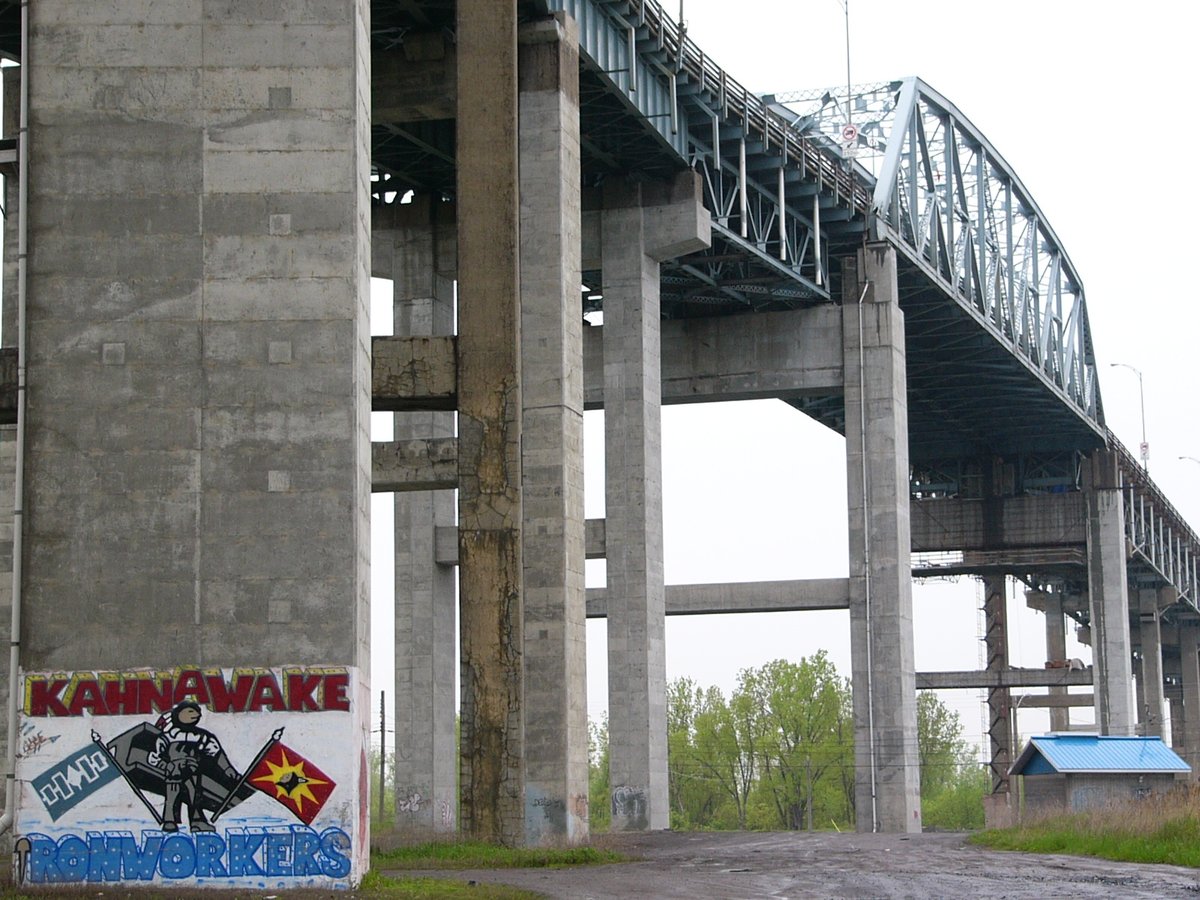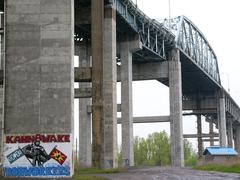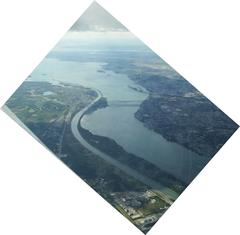
Honoré Mercier Bridge Montreal: Visiting Hours, Tickets, and Travel Guide
Date: 14/06/2025
Introduction
The Honoré Mercier Bridge is a vital and multifaceted landmark in Montreal, serving as a crucial transportation artery while standing as a powerful symbol of cultural connection and engineering prowess. Linking the Island of Montreal with the South Shore—specifically the LaSalle borough, the Kahnawà:ke Mohawk Territory, and the suburb of Châteauguay—the bridge is deeply interwoven with the region’s history, Indigenous relations, and urban development. This comprehensive guide provides essential information on visiting hours, access, travel tips, nearby attractions, and the bridge’s broader cultural and historical context. Whether you are a local commuter, a history enthusiast, or a visitor interested in Montreal’s architectural and cultural heritage, this guide will help you plan a meaningful and safe visit to the Honoré Mercier Bridge.
Table of Contents
- Introduction
- Origins and Early Construction
- Architectural and Engineering Features
- Indigenous Relations and Community Involvement
- The Oka Crisis and Social Significance
- Visiting the Bridge: Hours, Access, and Tickets
- Nearby Attractions
- Maintenance, Modernization, and Future Plans
- Social Impact and Community Relations
- Frequently Asked Questions (FAQ)
- Conclusion
- References
Origins and Early Construction
Construction of the original Mercier Bridge began in the late 1920s amid rapid urban and industrial growth in Montreal, driven by the need for improved river crossings. Officially opened in 1934, the bridge was named after Honoré Mercier, a former Premier of Quebec known for his advocacy of provincial autonomy and social reform. The bridge’s initial span measured approximately 1.3 kilometers and featured a steel arch at its center, a testament to the engineering ambitions of the era (athomeincanada.ca).
Architectural and Engineering Features
The Honoré Mercier Bridge was Quebec’s fourth bridge over the St. Lawrence River, following the Victoria, Jacques Cartier, and Champlain bridges. It was designed for both vehicular and rail traffic, embodying a combination of steel and reinforced concrete for durability. In the 1960s, a parallel span was added to accommodate growing vehicular demand, expanding the bridge to four lanes (athomeincanada.ca). The structure’s central steel arch has become an enduring symbol of resilience, withstanding the river’s strong currents and harsh winters.
Indigenous Relations and Community Involvement
The bridge’s path across the Kahnawà:ke Mohawk reserve underscores its unique role in Indigenous and regional relations. Mohawk ironworkers were instrumental in the original construction and subsequent expansions. The Mohawk Bridge Consortium—a group of contractors from Kahnawà:ke—has led major maintenance and modernization projects, reflecting a collaborative approach between the Quebec government and the Mohawk Council (Jacques Cartier Champlain Bridge Corporation).
In recent years, the bridge has also become a platform for artistic expression and cultural recognition. In 2023, banners by Mohawk artists were installed on the bridge, celebrating Indigenous creativity and heritage.
The Oka Crisis and Social Significance
The Honoré Mercier Bridge has repeatedly been a focal point for political action and protest. During the 1990 Oka Crisis, Mohawk warriors from Kahnawà:ke blockaded the bridge for weeks in solidarity with the Kanehsatà:ke Mohawk community, drawing national and international attention to Indigenous land rights. The blockade’s disruption of daily commutes underscored the bridge’s importance and the urgency of dialogue on Indigenous issues (Harvard International Review).
More recently, in 2022, Kahnawà:ke youth again used the bridge as a platform for protest, briefly stopping traffic to oppose Bill 96, a Quebec language law viewed as threatening the Mohawk language (CBC News). These episodes highlight the bridge’s ongoing social and political relevance.
Visiting the Bridge: Hours, Access, and Tickets
Visiting Hours and Ticket Information
The Honoré Mercier Bridge is an active public roadway open 24 hours a day for vehicular traffic. There are no specific visiting hours or tickets required for crossing the bridge by vehicle. Pedestrian and cyclist access is currently not permitted on the bridge itself due to safety and ongoing construction concerns.
Travel Tips
- Best Times to Visit: Early mornings or late evenings on weekdays help avoid heavy traffic.
- Parking: Parking is available in LaSalle and Châteauguay near popular viewpoints.
- Public Transit: Bus routes connect Montreal to LaSalle and Kahnawà:ke. Use the Montreal Metro Green Line to Angrignon station, then the 106 bus to reach the area (Montreal In Pictures).
- Traffic and Maintenance: The bridge is a busy commuter route, with frequent maintenance and occasional lane closures, especially on weekends. Check Transports Quebec or call 511 for real-time updates (CityNews Montreal), (cybersoleil.com).
- Accessibility: While the bridge itself is not accessible to pedestrians or cyclists, nearby parks and viewpoints offer accessible paths for visitors with mobility needs.
Nearby Attractions
- Parc des Rapides: Scenic park along the LaSalle shoreline, offering panoramic views of the bridge and the St. Lawrence River.
- Fleming Windmill: A historic windmill built in 1815, open to the public on weekends from mid-May to August (Montreal In Pictures).
- Seagram’s Distillery Water Tower: An industrial heritage site near the bridge.
- Kahnawà:ke Cultural Sites: Visit museums and cultural centers to learn about Mohawk heritage and ongoing artistic initiatives.
Maintenance, Modernization, and Future Plans
With approximately 75,000 vehicles crossing daily, the Honoré Mercier Bridge undergoes regular maintenance and modernization. Recent projects include major deck replacements and structural repairs, often spearheaded by the Mohawk Bridge Consortium (cybersoleil.com). The Quebec Infrastructure Plan (2023–2033) proposes future enhancements, including the potential addition of dedicated pedestrian and cycling paths (athomeincanada.ca), (Quebec Ministry of Transport).
Social Impact and Community Relations
The bridge’s construction and operation have provided significant employment and economic benefits, particularly for Mohawk ironworkers, while facilitating access and growth for the wider region (Jacques Cartier Champlain Bridge Corporation). However, it has also been a flashpoint during periods of social tension, such as the Oka Crisis, prompting ongoing reconciliation efforts and inclusive dialogue. Recent collaborations emphasize consultation and shared management, fostering trust and mutual respect.
The bridge has also been the site of tragic incidents, such as the suicide in April 2025, which reignited discussions about mental health support and prevention measures (Elegant News).
Frequently Asked Questions (FAQ)
Q: What are the Honoré Mercier Bridge visiting hours?
A: The bridge is a public roadway open 24/7 for vehicles. There are no designated visiting hours.
Q: Do I need tickets to visit or cross the Honoré Mercier Bridge?
A: No, tickets or tolls are not required.
Q: Is the bridge accessible to pedestrians or cyclists?
A: No, pedestrian and cycling access is currently not permitted for safety reasons.
Q: Where can I get the best views of the Honoré Mercier Bridge?
A: Excellent vantage points include Parc des Rapides (LaSalle), the Fleming Windmill area, and viewpoints in Kahnawà:ke.
Q: Are guided tours available?
A: There are no official guided tours of the bridge, but local historical sites and city tours sometimes include it as a point of interest.
Q: Is the area accessible for visitors with mobility challenges?
A: Many viewpoints in LaSalle and near local parks are accessible, though some may require traversing uneven ground.
Conclusion
The Honoré Mercier Bridge is a living emblem of Montreal’s engineering achievements, cultural diversity, and the spirit of connection between communities. While direct pedestrian or cyclist access is currently not available, the bridge’s surrounding parks, waterfronts, and historical sites offer rich opportunities for sightseeing, photography, and cultural exploration. By staying informed about traffic patterns, maintenance schedules, and leveraging resources like the Audiala app and official transport websites, visitors can ensure a rewarding and safe experience.
Whether you are admiring its architecture, reflecting on its role in historic events, or exploring the neighboring attractions, the Honoré Mercier Bridge invites you to engage with Montreal’s layered past and dynamic present.
Download the Audiala app for real-time alerts and comprehensive travel guides, and follow us on social media for more insights and updates on Montreal landmarks and events.
References
- The Mercier Bridge – athomeincanada.ca
- Honoré Mercier Bridge History – Jacques Cartier Champlain Bridge Corporation
- The Oka Crisis – Harvard International Review
- Mercier Bridge Maintenance Updates – Cyber Soleil
- Quebec Ministry of Transport Infrastructure Projects
- Kahnawake Youth Protest – CBC News
- Honoré Mercier Bridge Incident – Elegant News
- Montreal In Pictures – Honoré Mercier Bridge
- CityNews Montreal – Bridge Closures
- Transports Quebec
- Mobilité Montréal





























































































































